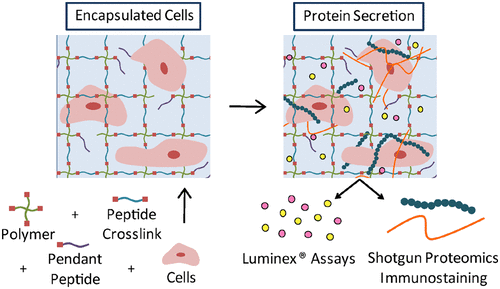当前位置:
X-MOL 学术
›
ACS Biomater. Sci. Eng.
›
论文详情
Our official English website, www.x-mol.net, welcomes your
feedback! (Note: you will need to create a separate account there.)
Isolation and Identification of Proteins Secreted by Cells Cultured within Synthetic Hydrogel-Based Matrices.
ACS Biomaterials Science & Engineering ( IF 5.4 ) Pub Date : 2018-02-03 , DOI: 10.1021/acsbiomaterials.7b00647 Lisa A Sawicki 1 , Leila H Choe 1, 2 , Katherine L Wiley 1 , Kelvin H Lee 1, 2 , April M Kloxin 1, 3
ACS Biomaterials Science & Engineering ( IF 5.4 ) Pub Date : 2018-02-03 , DOI: 10.1021/acsbiomaterials.7b00647 Lisa A Sawicki 1 , Leila H Choe 1, 2 , Katherine L Wiley 1 , Kelvin H Lee 1, 2 , April M Kloxin 1, 3
Affiliation

|
Cells interact with and remodel their microenvironment, degrading large extracellular matrix (ECM) proteins (e.g., fibronectin, collagens) and secreting new ECM proteins and small soluble factors (e.g., growth factors, cytokines). Synthetic mimics of the ECM have been developed as controlled cell culture platforms for use in both fundamental and applied studies. However, how cells broadly remodel these initially well-defined matrices remains poorly understood and difficult to probe. In this work, we have established methods for widely examining both large and small proteins that are secreted by cells within synthetic matrices. Specifically, human mesenchymal stem cells (hMSCs), a model primary cell type, were cultured within well-defined poly(ethylene glycol) (PEG)-peptide hydrogels, and these cell-matrix constructs were decellularized and degraded for subsequent isolation and analysis of deposited proteins. Shotgun proteomics using liquid chromatography and mass spectrometry identified a variety of proteins, including the large ECM proteins fibronectin and collagen VI. Immunostaining and confocal imaging confirmed these results and provided visualization of protein organization within the synthetic matrices. Additionally, culture medium was collected from the encapsulated hMSCs, and a Luminex assay was performed to identify secreted soluble factors, including vascular endothelial growth factor (VEGF), endothelial growth factor (EGF), basic fibroblast growth factor (FGF-2), interleukin 8 (IL-8), and tumor necrosis factor alpha (TNF-α). Together, these methods provide a unique approach for studying dynamic reciprocity between cells and synthetic microenvironments and have the potential to provide new biological insights into cell responses during three-dimensional (3D) controlled cell culture.
中文翻译:

合成水凝胶基质中培养的细胞分泌的蛋白质的分离和鉴定。
细胞与其微环境相互作用并重塑其微环境,降解大的细胞外基质(ECM)蛋白(例如纤连蛋白、胶原蛋白)并分泌新的ECM蛋白和小可溶性因子(例如生长因子、细胞因子)。 ECM 的合成模拟物已被开发为受控细胞培养平台,可用于基础研究和应用研究。然而,细胞如何广泛地重塑这些最初明确的矩阵仍然知之甚少且难以探究。在这项工作中,我们建立了广泛检查合成基质中细胞分泌的大蛋白和小蛋白的方法。具体来说,人间充质干细胞(hMSC)是一种模型原代细胞类型,在明确的聚(乙二醇)(PEG)-肽水凝胶中培养,这些细胞基质构建体被脱细胞和降解,用于随后的分离和分析。沉积的蛋白质。使用液相色谱和质谱的鸟枪蛋白质组学鉴定了多种蛋白质,包括大型 ECM 蛋白纤连蛋白和 VI 型胶原蛋白。免疫染色和共聚焦成像证实了这些结果,并提供了合成基质内蛋白质组织的可视化。此外,从封装的 hMSC 中收集培养基,并进行 Luminex 测定以鉴定分泌的可溶性因子,包括血管内皮生长因子(VEGF)、内皮生长因子(EGF)、碱性成纤维细胞生长因子(FGF-2)、白细胞介素8 (IL-8) 和肿瘤坏死因子 α (TNF-α)。 这些方法共同提供了一种独特的方法来研究细胞和合成微环境之间的动态互惠性,并有可能为三维 (3D) 控制细胞培养过程中的细胞反应提供新的生物学见解。
更新日期:2018-02-03
中文翻译:

合成水凝胶基质中培养的细胞分泌的蛋白质的分离和鉴定。
细胞与其微环境相互作用并重塑其微环境,降解大的细胞外基质(ECM)蛋白(例如纤连蛋白、胶原蛋白)并分泌新的ECM蛋白和小可溶性因子(例如生长因子、细胞因子)。 ECM 的合成模拟物已被开发为受控细胞培养平台,可用于基础研究和应用研究。然而,细胞如何广泛地重塑这些最初明确的矩阵仍然知之甚少且难以探究。在这项工作中,我们建立了广泛检查合成基质中细胞分泌的大蛋白和小蛋白的方法。具体来说,人间充质干细胞(hMSC)是一种模型原代细胞类型,在明确的聚(乙二醇)(PEG)-肽水凝胶中培养,这些细胞基质构建体被脱细胞和降解,用于随后的分离和分析。沉积的蛋白质。使用液相色谱和质谱的鸟枪蛋白质组学鉴定了多种蛋白质,包括大型 ECM 蛋白纤连蛋白和 VI 型胶原蛋白。免疫染色和共聚焦成像证实了这些结果,并提供了合成基质内蛋白质组织的可视化。此外,从封装的 hMSC 中收集培养基,并进行 Luminex 测定以鉴定分泌的可溶性因子,包括血管内皮生长因子(VEGF)、内皮生长因子(EGF)、碱性成纤维细胞生长因子(FGF-2)、白细胞介素8 (IL-8) 和肿瘤坏死因子 α (TNF-α)。 这些方法共同提供了一种独特的方法来研究细胞和合成微环境之间的动态互惠性,并有可能为三维 (3D) 控制细胞培养过程中的细胞反应提供新的生物学见解。









































 京公网安备 11010802027423号
京公网安备 11010802027423号